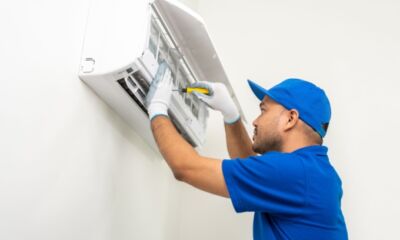How much does split system air conditioning installation cost?
When the heat is on or the temperature drops, homeowners might start to think about installing a split-system air conditioner. We look at which air conditioner you might need and how much they cost to install.

When the heat is on or the temperature drops, homeowners might start to think about installing a split-system air conditioner. We look at which air conditioner you might need and how much they cost to install.
Australia is a country of weather extremes when it comes to temperature, and it only seems to be getting worse. The Bureau of Meteorology and CSIRO’s State of the Climate report found that Australia’s climate has warmed on average by 1.47 degrees Celsius since records began in 1910. This has led to an increase in the frequency of extreme heat events.
So perhaps it is no surprise that, according to Monash University’s Digital Energy Futures project, almost 80% of Australian homes now have some form of air conditioning. However, air conditioning can be expensive to install and run. The Federal Government’s Department of Climate Change, Energy, the Environment and Water suggests heating and/or cooling can account for between 20% to 50% of your household energy usage. This is why, when choosing your air conditioner, it’s worth considering the size and efficiency of the model.
In terms of efficiency, many air conditioners are now required to display a Zoned Energy Rating Label (ZERL). This goes a step further than the old Energy Rating stickers, by showing a seasonal efficiency rating for three distinct climate zones – hot, average, and cold. This can help you select an air conditioner that’s suitable for your climate zone. For example, the government’s energyrating.gov.au website states that Brisbane and Darwin are considered to be in the hot zone, Adelaide, Perth and Sydney in the average zone and Hobart, Melbourne and Canberra in the cold zone. Ratings are up to a maximum of 10 stars for both heating and cooling. Also included in the new labelling system is a noise indicator to show the volume, in decibels, of the internal and external units. Labels on ducted systems are voluntary, so not all products will have one.
How much does it cost to install a split-system air conditioner?
Installing a split-system air conditioner in Australia can typically cost from $600 to $1,500, according to trade services website hipages.com.au. Installation must be performed by a licensed technician who will charge you an additional $60-$110 plus GST per hour for installation.
The final figure you will pay depends on many factors:
- The type and size of the unit.
- How much ducting, piping, cabling and other items are required.
- The site of the installation; including access, which part of the house it will be placed and how the units will be drained.
- The electrical infrastructure of the home; which in some cases may require an upgrade to the main power board and the installation of safety switches.
Plumbers, electricians and specialist air conditioner installers can perform the installation, providing they are licensed to handle refrigerants as well as their regular qualifications. It’s a good idea to collect a few quotes for installation before making any decisions.
What are the options to finance installing a split-system air conditioner?
How the purchase of a unit and its installation is financed may depend on how much it costs. There are several options available to consider, including:
- Personal savings. If you have savings tucked away, it can make sense to dip into your spare cash to pay for a split system. It’s an interest-free option, and there is always the possibility that a retailer may offer a cash discount.
- Personal loan. Depending on your personal circumstances and the cost of the job, you may consider taking out a personal loan to fund the work. This could be a secured loan, or an unsecured loan. It’s worth keeping in mind though, that interest rates are generally higher for personal loans than for home loans.
- Green loan. A number of lenders offer ‘green loans’ – a type of personal loan designed to help homeowners purchase eligible energy-efficient appliances like air conditioners. As a general rule, the air conditioner will need to meet minimum energy efficiency requirements, but if you’re eligible, green loans can come with very competitive interest rates.
- Credit card. It may also be possible, depending on the cost and your ability to repay the debt quickly, to pay for your new air conditioner with a credit card. There could be some fringe benefits for doing so, such as extra insurance cover in some cases (read the card’s Product Disclosure Statement to find out the conditions of the cover). Keep in mind that credit card interest rates are typically much higher than home or personal loans, and interest can quickly accumulate on large balances. With this in mind, it’s a good idea to weigh up your options and consider them carefully. If you don’t think you’ll be able to pay off the card’s balance in full each month, it may be worth seriously re-considering whether a credit card is the right option for you.
→ Want to know more? Financing a Renovation – Loan, Refinance, or Out of Pocket?
What type of air conditioning units are available?
Refrigerant systems
A common air conditioning unit in Australia is a refrigerant system. Working much like a refrigerator, a liquid refrigerant is piped through the system to cool air. Reverse-cycle systems – as the name suggests – can reverse this process to heat the air, and are the most common unit sold. All units require a condenser (which cools the refrigerant), a fan, and a drainage system. Below are some common refrigerant air conditioners:
- Portable. These units are typically only suited for small spaces and have wheels so they can be moved around. They typically do not require installation, however many models do need access to a window, floor or sink drain, to allow air exchange and water to drain away. You can compare portable air conditioners with Canstar Blue.
- Window or wall units. These units – also known as ‘window’ air conditioners – are installed in a wall or take up part of a window opening. The unit faces inside the room you want to temperature control, whilst the exhaust fan and water drainage are outside. They usually require an inside power point. These units are typically only suited to small to medium spaces. Expert installation may be required.
- Reverse cycle split system. This type of air conditioner typically heats and cools small to large rooms, and – as the name suggests – is made up of two separate components linked by cables and hoses. The head unit is hung on the wall near the ceiling in the room you want to temperature control. The condenser unit is typically larger and is installed outside the home. This unit usually contains a motor and a fan. Split systems need access to drainage, so that the water they collect from the air can escape. Typically, you will need a licensed installer to add one to your home due to the complex electrical, drainage and carpentry requirements. These units are also available as ‘multi-head’ systems, which allow multiple rooms to be temperature controlled.
For energy efficiency, split systems with an ‘inverter’ could be worth a look. The role of an inverter is to adjust the compressor speed according to the room’s temperature. This can give these units a better operating efficiency than conventional fixed speed systems.
Ducted
These systems can usually heat or cool multiple rooms, or an entire home, depending on the size of the unit and the number of “zones” it allows. Typically, cool or warm air flows from vents installed into various rooms; travelling there via ducts in the ceiling cavity from an indoor air control unit and an outdoor condenser unit. These types of units can only be installed by an expert professional, and you could be looking at an installation cost of between $6,000 to $10,000 for smaller homes and apartments, and up to $30,000 for larger homes.
→ Trouble deciding which type of unit? This story from Canstar Blue may help: Ducted vs Split System Air Con: Pros & Cons
Evaporative systems
Evaporative coolers use the heat exchange effect of evaporating water to cool the air, according to Sustainability Victoria. These systems work best in hot, dry weather, but are not suited to humid conditions. An evaporation unit sits on top of the house and draws in hot air over moist pads. The moist, cooled air is then blown into the home.
How large must the air conditioner be?
The size of the area that needs to be temperature-controlled determines the size of the air conditioner that you will need. Air conditioner size is determined by the wattage of the unit. Appliancesonline.com.au notes that, generally you’ll need about 0.15 kilowatts per square metre. This can be influenced by factors such as if the room is open to the rest of the house or if it receives a lot of sun. Below is a table detailing the estimated kilowatt requirement for small, medium and large sized rooms.
| Small room | Medium room | Large room | |
|---|---|---|---|
| Size | 10-20 square metres | 20-40 square metres | 40-60 square metres |
| Minimum kilowatts required | 2.8kW | 4.2kW | 5.6kW |
| Ideal types of air conditioner | Portable, wall mounted, split system | Wall mounted, split system | Split system |
Source: Appliancesonline.com.au
Finally, bear in mind that different states and territories may also have legal regulations around what air conditioners you can install, so it could be worth checking with your state or territory government to ensure your unit is compliant.
Compare Home and Contents Insurance with Canstar
If you’re comparing home and contents insurance policies, the comparison table below displays some of the policies currently available on Canstar’s database for an Australian aged under 50, seeking cover in NSW or the ACT for a cost to replace contents of below $75,000. Please note the table is sorted by Star Rating (highest to lowest), followed by provider name (alphabetical) and features links direct to the providers’ websites. Consider the Product Disclosure Statement (PDS) and Target Market Determination (TMD), before making a purchase decision. Contact the product issuer directly for a copy of the PDS and TMD. Use Canstar’s home insurance comparison selector to view a wider range of policies. Canstar may earn a fee for referrals.
 24/7 claims
24/7 claims
 Online discount
Online discount
 New for old
New for old
Products displayed above that are not “Sponsored or Promoted” are sorted by Star Rating and then alphabetically by company. Canstar may receive a fee for referral of leads from these products. See How We Get Paid for further information. If you decide to apply for Home Insurance or Contents Insurance, you will deal directly with an insurance provider, and not with Canstar.
Consider the provider’s detailed product and pricing information before making a decision to purchase a policy. The products displayed on this page do not include all providers and may not compare all features relevant to you. View the Home Insurance Methodology and Report. The Star Rating shown is only one factor to take into account when considering products.
Main image source: e2dan/Shutterstock.com.
This article was reviewed by our Content Lead, Canstar Mandy Beaumont before it was updated, as part of our fact-checking process.

The comparison rate for all home loans and loans secured against real property are based on secured credit of $150,000 and a term of 25 years.
^WARNING: This comparison rate is true only for the examples given and may not include all fees and charges. Different terms, fees or other loan amounts might result in a different comparison rate.

Up to $4,000 when you take out a IMB home loan. Minimum loan amounts and LVR restrictions apply. Offer available until further notice. See provider website for full details. Exclusions, terms and conditions apply.
 Owner occupied
Owner occupied
 20% min deposit
20% min deposit
 Redraw facility
Redraw facility
Try our Home Loans comparison tool to instantly compare Canstar expert rated options.
The comparison rate for all home loans and loans secured against real property are based on secured credit of $150,000 and a term of 25 years.
^WARNING: This comparison rate is true only for the examples given and may not include all fees and charges. Different terms, fees or other loan amounts might result in a different comparison rate.






